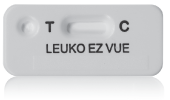Overview
 Gastrointestinal diseases often share similar symptoms, such as abdominal pain and diarrhea. Treatment will vary from simple rehydration to powerful antibiotics depending on the diagnosis. It can often be difficult to pinpoint the cause of disease, and physicians will often use the presence of intestinal inflammation as a clue to the possible cause and treatment of symptoms.
Gastrointestinal diseases often share similar symptoms, such as abdominal pain and diarrhea. Treatment will vary from simple rehydration to powerful antibiotics depending on the diagnosis. It can often be difficult to pinpoint the cause of disease, and physicians will often use the presence of intestinal inflammation as a clue to the possible cause and treatment of symptoms.
The Problem
Physicians often rely on fecal white blood cell (WBC) testing to identify if inflammation is present in a patient. The most common method of detection is fecal WBC smear microscopy. However, fecal WBCs break down rapidly in the stool, making visual identification difficult with traditional microscopy. This is particularly problematic in diseases, such as C. difficile or Shiga-toxin E. coli (STEC) where inflammation is common, yet the bacterial toxins destroy WBCs.
Consequences
The breakdown of fecal WBCs in a patient's sample limits the ability to identify inflammation using microscopy. This leads to an increased risk of a false negative microscopy result, which may influence a physician's assessment of a patient and their course of treatment. By detecting a stable biomarker of WBCs, such as lactoferrin, we can detect even low levels of inflammation regardless of the breakdown of WBCs in a sample.
Rapid Testing
The unique Alere LEUKO EZ VUE™ assay detects lactoferrin, a marker of fecal WBCs, in stool samples. Detection of lactoferrin provides an accurate identification of inflammation in a patient even if there is advanced cellular breakdown due to cytotoxins or prolonged sample storage.
Antimicrobial Stewardship Program Diseases
Featured Product

Alere LEUKO EZ VUE
LEUKO EZ VUE can detect elevated levels of fecal lactoferrin, a marker of fecal leukocytes and an indicator of intestinal inflammation.
